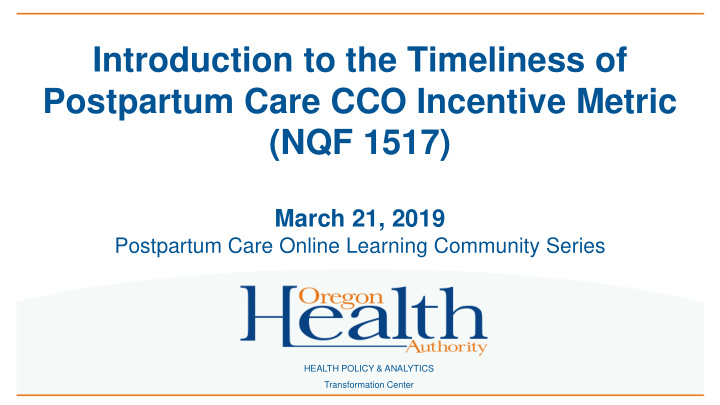



Introduction to the Timeliness of Postpartum Care CCO Incentive Metric (NQF 1517) March 21, 2019 Postpartum Care Online Learning Community Series HEALTH POLICY & ANALYTICS Transformation Center
Presenters • Amit Shah, MD, Care Oregon (Metrics & Scoring Committee Vice- chair) • Sara Kleinschmit, MSc, OHA Health Analytics • Anna Stiefvater, RN, MPH, OHA Maternal and Child Health 2
Agenda • Importance of measure, and Metrics & Scoring Committee vision (Dr. Shah) • Overview of measure specifications (Sara) • Current performance (Sara) • Guidance document overview (Sara and Anna) • Discussion, Q&A (all) 3
Importance of Postpartum Care
Fourth Trimester (3 months postpartum) • Challenges – Recovery from pregnancy, labor & delivery and newborn care – Return to tobacco use (and other substance use) – Fragmented care – Little formal or informal support • Opportunities – Reproductive life planning and contraception – Management of chronic health conditions – Linkages to ongoing care & services – Sensitive period of time with links to life course outcomes (maternal depression, breastfeeding)
State of Health Care Quality Report: HEDIS Measures of Care (United States) POSTPARTUM VISIT BETWEEN 21 AND 56 DAYS AFTER DELIVERY Commercial Medicaid Medicare Year HMO PPO HMO HMO PPO 2016 74.1 65.9 63.7 -- -- 2015 73.2 63.1 60.9 – – 2014 76.9 68.4 61.8 – – 2013 80.7 70.9 61.3 – – 2012 80.1 70.0 63.0 – – 2011 80.6 71.3 64.1 – – 2010 80.7 65.9 64.4 – – National Committee for Quality Assurance (NCQA) http://www.ncqa.org/report-cards/health-plans/state-of-health-care- quality/2017-table-of-contents/perinatal-care 6
Metrics & Scoring Committee Vision and Rationale for Incentivizing Measure • The Health Plan Quality Metrics Committee has indicated its intention to change this measure to focus on quality of the postpartum visit as early as 2021 . Focus on supporting women in attending their visits now sets system up for success on this new measure. • Aligns with efforts to reduce maternal mortality and morbidity and helps address racial and ethnic disparities in this area (e.g., new Oregon Maternal Mortality and Morbidity Review Commission; inequities in postpartum outcomes for women of color). • Work in postpartum arena supports CCOs in other areas , including effective contraceptive use measure. • Postpartum care essential to interconception health , setting state for healthy subsequent pregnancy and birth. • Aligned with recently endorsed kindergarten readiness measurement strategy, which notes the importance of caregiver health in child health and outcomes.
Measure Overview • Overview : Percentage of live birth deliveries for which there is a subsequent, timely postpartum visit • Data Source : – Denominator (deliveries): Administrative data (MMIS/DSSURS) – Numerator (visits): MMIS/DSSURS, medical records (hybrid: chart review + claims) Equation : • A postpartum visit for a pelvic exam or postpartum care on or between 21 and 56 days after delivery = All live birth deliveries with estimated delivery date (EDD) in the ‘intake period’: between November 6 of the year prior to the measurement year, and November 5 of the measurement year, and the members of the organization who meet the continuous enrollment criteria. 8
Measure Overview • Continuous Enrollment Criteria : 43 days prior to the Estimated Date of Delivery (EDD) through 56 days after EDD with no gaps • Important Note : – OHA identifies the live birth deliveries from administrative data and provide CCOs with a random sample delivery list for the chart review (411/CCO) – Chart review criteria: A postpartum visit to an OB/GYN practitioner or midwife, family practitioner or other PCP. Documentation in the medical record must include a note indicating the date on which a postpartum visit occurred and documentation of specific care provided (e.g., pelvic exam) 9
CCO Performance - 2017 10
Measure: Timeliness of Postpartum Care 11
Guidance Document • NEW guidance document now available here : https://www.oregon.gov/OHA/HPA/ANALYTICS/Pages/CCO-Baseline-Data.aspx • Sections on: – Why measure is important – Brief measure overview with link to detailed specifications – How CCOs can improve on measure • Highlight whether CCO, clinic, or community-level strategy – Spotlights on promising practices 12
Guidance Document – Improvement Strategies • Care Delivery Strategies – Provide patient education and outreach – Offer peer support – Offer enhanced Maternity Care models – Provide comprehensive case management and care management – Facilitate access to appointments – Use technology and incentives • Payment Strategies 13
Guidance Document – Strategies Organized by Role 14
Guidance Document – Spotlights • Local innovations around postpartum care –Maternal medical homes –Incentive programs –Case management 15
Postpartum Care Online Learning Community Series 1 st & 3 rd Thursdays through June 20, 2019 Noon – 1 p.m. Upcoming sessions: • April 4: Why postpartum care matters: Implications for health systems, clinics and patients • April 18: Understanding and addressing barriers to postpartum care: Systems- and clinic-level strategies • May 2: Postpartum Care Online Learning Community Series: Central Oregon Perinatal Continuum of Care • Additional sessions coming soon! Information and registration: https://www.oregon.gov/oha/HPA/dsi- tc/Pages/Timeliness-Postpartum-Care.aspx 16
Questions? 17
Resources • Measure specifications and guidance documents: www.oregon.gov/oha/analytics/Pages/CCO-Baseline-Data.aspx • metrics.questions@dhsoha.state.or.us • Timeliness of Postpartum Care Technical Assistance: https://www.oregon.gov/oha/HPA/dsi-tc/Pages/Timeliness-Postpartum- Care.aspx • elizabeth.m.stuart@dhsoha.state.or.us 18
Recommend
More recommend